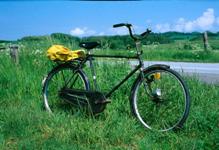 One of the best ways to see the countryside and appreciate the beauty of the land is to travel by bicycle. All you need is a pack with the basic necessities, a good quality touring bike and a lot of energy, and you'll be on your way to seeing the world in a whole new way.
One of the best ways to see the countryside and appreciate the beauty of the land is to travel by bicycle. All you need is a pack with the basic necessities, a good quality touring bike and a lot of energy, and you'll be on your way to seeing the world in a whole new way.
Touring bicycles, as the name suggests, are used by cyclists wanting to travel while carrying supplies. These bicycles have racks mounted on the front and rear of the frame for carrying the extra gear like a change of clothes, food etc. They have mudguard mounting points, triple water bottle mounts, a large wheelbase and a suitable frameset for wider tires.
Types of bikes
Road, recumbent and tandem bikes are the three most popular touring bicycles in use today. Each style of bike has its own distinct advantages and disadvantages. Learn about the different touring bikes and choose one according to your particular needs.
The classic style of road touring bicycle has 700C wheels. The diameter of the wheels is the same as a racing bike, but the rims are wider and there is more frame clearance. Manufacturers have recently begun to modify the 26-inch mountain bike tires, allowing them to provide more strength and better resistance.
Recumbent touring bicycles are unique in appearance due to the seat position. Riders sit on a reclined seat with the legs stretched out in front. The steering can be positioned above or below the seat level.
Also known as "bicycles built for tow", tandem touring bikes are perfect for a couple looking for an economical way to travel together. These bikes can't handle the additional weight of storage and gear, so the riders may want to hitch a trailer to bring their supplies along for the ride.
Most modern touring bikes are equipped with road handlebars, front and rear luggage racks and saddles designed for long distance comfort. These bikes also feature heavy-duty rims, 36-spoke wheels and rugged hubs to increase their reliability and stability over long trips. A longer wheelbase and stable steering arrangement adds to this enduring practicality. On many touring bikes, a longer chain stay helps to ensure that cyclists are able to ride longer distances without discomfort.
Touring bikes have various attachment points for keeping luggage, fixing fenders and storing their all-important water bottles. Some models allow for space to store spare parts. Another option is to attach a trailer, which can be towed behind the bike to carry extra gear and provide a low center of gravity.
Touring bicycles are built to handle the elements and carry the rider over long distances. The frame and parts are made of sturdy, long lasting materials, allowing the bikes to handle fast ascents and descents even when loaded down with gear. Normal caliper brakes used in racing bikes are replaced by cantilever or lever-pulled brakes. Some manufacturer even use disc brakes to provide excellent stopping power.
The added utility and ruggedness are usually gained at the expense of speed, but this is a compromise that touring cyclists are willing to make. The unique combination of features and benefits are what makes the touring bike the ride of choice for adventurous travelers who want an up close and personal view of the countryside.









Join the Discussion
Type out your comment here:
You must be logged in to post a comment.